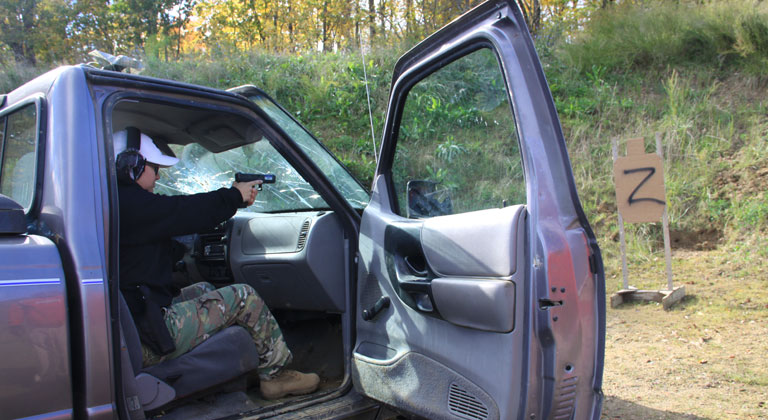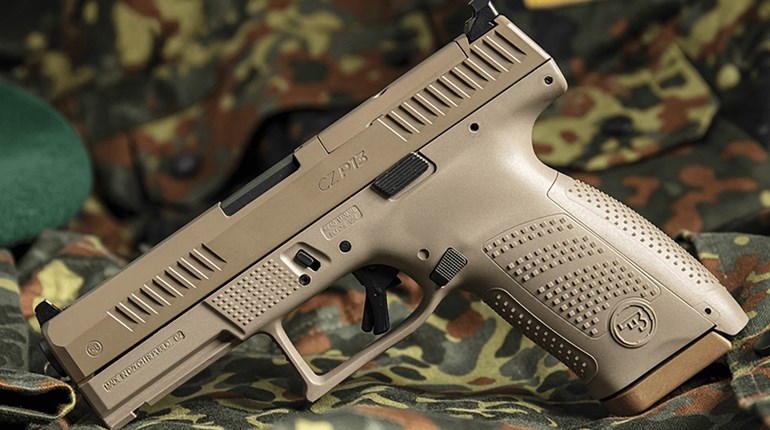
As more and more firearms owners in America seek advanced-handgun training, more and more private shooting ranges are seeing this demand and filling the need. One of those ranges in Ohio is East Group Training Concepts.
Usually open only to law enforcement and military personnel, during the past year the range has hosted half a dozen advanced firearms training courses for the public through the Buckeye Firearms Association (www.BuckeyeFirearms.org). One of the unique training opportunities East Group offers is firing a handgun through the front windshield of a vehicle—from the inside out. I just had to try it, so I arranged for an hour or two of one-on-one instruction with head instructor Sly.
As a concealed-carry permit holder you may think that shooting through a windshield or side window from the inside of a vehicle is only a remote real-life possibility, but Sly disagrees.
“Carjackings are on the rise in the U. S., so to protect yourself you may be forced to shoot from inside your vehicle,” he said. “Most carjackings occur when a vehicle is stopped, either at a stoplight or possibly when a person has pulled into or is leaving a parking lot. And during those times most people have their doors unlocked, and they’re not paying attention to what’s happening around them. Their mind is on the particular errand they’re running or they may be talking on a cell phone, so their vulnerability is high.”
Sly added that your first and best defense in an attempted carjacking/robbery is to put the vehicle in gear, if it’s not already, and step on the gas. But if for some reason you can’t do that, you then may be forced to fight.
Does shooting through a windshield deflect the flight of a handgun bullet significantly? The short answer to that question, according to Sly, is yes. “But as with any ricochet, you never really know how much the bullet will be affected,” he said. “Let me show you…”
He placed a large paper target immediately in front of an older model SUV, no farther than 10 to 12 feet away from where I sat in the driver’s seat. “Now, aim at the center of the target and fire one shot through the windshield,” he said.
I took my time aiming, pressed the trigger, and the bullet hit the target 2 feet higher than my aim point. “Shoot again,” said Sly. I repeated the shot and the bullet again hit 2 feet high. Both shots had deflected 2 feet from my point of aim in just 10 to 12 feet of distance—incredible!
“The deflection is due to the slant of the windshield,” he said. “When a bullet starts to penetrate glass, as it does any obstruction, it follows the path of least resistance. Meaning that as the tip of the bullet strikes the glass, the back of the bullet tilts downward, causing the bullet to fly high. When shooting through a windshield from the outside of a vehicle, the opposite occurs; the bullet deflects downward. But the overall effect is not as drastic from outside in because the distance from the windshield to a target in the front or back seats is usually not as great.”
I was shooting 9mm ball ammunition, unjacketed, and at times during my subsequent shots the bullet would fragment going through the glass, producing two hits on the target instead of just one. Sly said that even with full metal jacket ammo the glass will, at times, partially or completely strip the jacket from the bullet. “You just never know for sure what a bullet will do when it hits an obstruction,” he said.
If you are ever involved in a possible gunfight situation, and you can’t drive away, Sly advises getting out of the vehicle. “By staying in the vehicle you’re essentially trapped and it’s difficult to maneuver to return fire. Every situation is different, but in most cases it’s better to exit the vehicle and seek cover than it is to stay inside.”
But what if you can’t exit? For instance, what if there are children or grandchildren in the vehicle with you? If the kids are old enough, Sly recommends having a code word that the kids quickly recognize, such as “gun!”
“When you say that word, the kids should immediately plug their ears with their fingers, tightly close their eyes, and put their head down. Because if you have to shoot there will be flying glass, and the report of a handgun in a vehicle is extremely LOUD. So loud in fact, that a young child could have his eardrums broken or hearing permanently damaged if his ears are not plugged.”
For the final part of my instruction, Sly placed a life-sized target of a bad guy in the front passenger seat of a vehicle and had me shoot through the windshield at it from about 15 feet in front of the vehicle. Again, most of my initial shots went high, but not because the bullets deflected. It was because of where I was looking.
“As humans, we’re hard-wired to look at each other’s faces,” he said. “And during a gunfight that is not good because you will instinctively shoot high. Instead, look and aim where you want the bullets to go—center mass—and they’ll go there.”
Sly made one last critical point. “Always remember that, as a civilian, you should pull your handgun only as a last resort, as a defensive weapon, never offensive. Because if you ever are forced to shoot someone, it will change their life and yours forever. The ramifications are many, not only physical, but legal, psychological and financial, as well. And that’s even if you are in the right.”
Sobering advice, for sure…
Note: Before trying this type of advanced-handgun training, make sure you are wearing adequate eye and ear protection plus a scarf that covers your nose and mouth, because small glass particles will be sent flying. In most American-made vehicles the glass in the windshield will spider web when hit by a bullet; side and rear windows will shatter into small, pea-sized pieces.






































